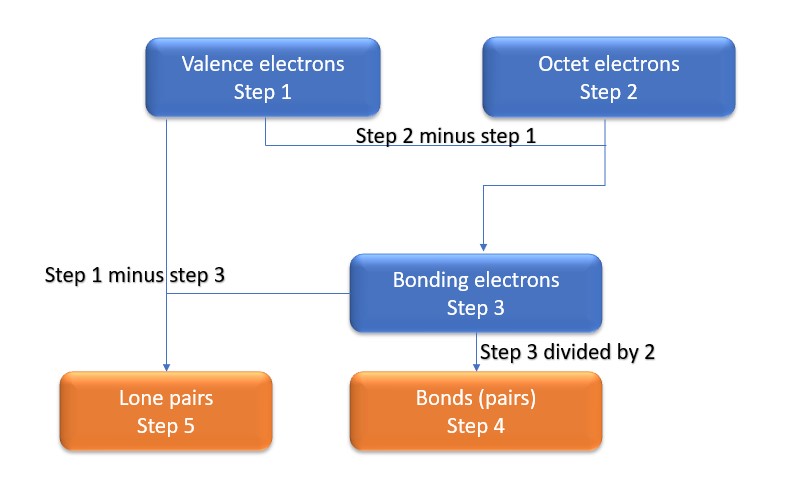What is the Lewis Structure of HCN?
What is the Lewis Structure of HCN? The Lewis structure of HCN has carbon triple bonded to nitrogen and single bonded to hydrogen. The molecule is linear.
What is this molecule and what is it used for?
HCN, hydrogen cyanide, is rather poisonous. HCN is a gas used primarily in chemical synthesis, mining, and polymer manufacturing. But serious, it’s dangerous, so stay away unless you are a legit chemist.
Method 1: Step method to draw the Lewis structure of HCN.
In this method, we find the bonds and lone pairs for the whole molecule, then plug it in to the atoms that we have to get the answer. Here is a little flow chart of how we are going to do this:

We will go through the steps below, but one thing to note here is that all the valence electrons (step 1) are either lone pairs OR bonding electrons. In other words…. Lone Pairs (Step 5) + Bonding electrons (Step 3) = Valence electrons (Step 1) . Let’s go through this example so we can see this a little more clearly.
Step 1: Find valence e– in all atoms. Add them together.
C=4
H=1
N = 5
Total=10
Step2: Find octet e- for each atom and add them together.
C=8
N=8
H = 2
Total=18
Step3: Gives you bonding e-. Subtract step 1 total from step 2
18-10=8e-
Step 4: Find number of bonds by diving the number in step 3 by 2(because each bond is made of 2 e-)
8e-/2= 4 bond pairs
Step 5: Find the number of nonbonding (lone pairs) e-. Subtract step 3 number from step 1.
10-8= 2e-=1 lone pair
Now, use the information from step 4 and 5 to draw the Lewis structures. Remembering too (this is important):
Neutral carbon has four bonds and no lone pairs
Neutral nitrogen has three bonds and one lone pair
Neutral hydrogen has one bond and no lone pairs.
[Note: For more information on the natural state of common atoms, see the linked post here.]
Carbon is the most electropositive, so let’s start with that in the middle. Then, we attach nitrogen and give it the three bonds and one lone pair it likes. Finally, we attach the hydrogen to the carbon to complete everyone’s octet and give the most stable Lewis structure of HCN.

Another (easier) method to determine the Lewis structure of HCN:
Alternatively a dot method can be used to draw the Lewis structure.
Calculate the total valence electrons in the molecule.
C : 1×4 = 4
N : 1×5 = 5
H: 1 x 1 = 1
Total = 10 valence electrons
Now, treat the atoms and electrons like puzzle pieces. We have to rearrange electrons to make sure everyone has an octet. Start with carbon as the central atom because it is the most electropositive. Make a single bond to each atom, then start changing the lone pairs to bonding electrons to make sure everyone get an octet [keeping in mind that hydrogen wants an “octet” of 2]

Frequently asked questions:
Q: So what is the difference between the two methods?
A: In the first method, we are figuring out all of the lone pairs and bonds first, then placing those electrons and bonds on the atoms to form a molecule. In the puzzle method, we already have lone pairs and bonding electrons assigned to each atom, so all we need to do is push puzzle pieces together to get a molecule. In each method, we need to remember the “happy state” of each atom, ei hydrogen likes 1 bond and no lone pairs, uncharged carbon likes four bonds and no lone pairs ect.
And now some video:
This is a quick video we put together that visually demonstrates the two methods for Lewis structure and Lewis dot problems.
And finally, the Lewis structure study guide:
Here it is, this is our one-page guide to Lewis Dot and Lewis Structures:

